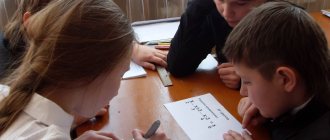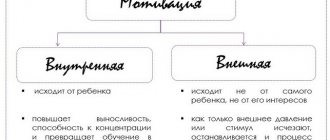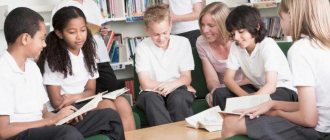Project. Project activities in primary school.. - presentation
Project. Project activities in elementary school.
History of the emergence of the project method The project method originated in the second half of the 19th century in US agricultural schools and was based on the theoretical concepts of “pragmatic pedagogy”, the founder of which was the American idealist philosopher John Dewey ( ). According to his views, only what is true and valuable is what is useful to people, what gives practical results and is aimed at the benefit of the whole society. The principle of pragmatic pedagogy: “learning through doing”
The project method is ways of organizing students’ independent activities to achieve a certain result. It is focused on interest, on the creative self-realization of the student’s developing personality, the development of his intellectual and physical capabilities, strong-willed qualities and creative abilities in the process of solving any problem that interests him.
The essence of project-based learning is that the student, in the process of working on an educational project, comprehends real processes and objects. It involves the student living through specific situations of overcoming difficulties; introducing him to penetration into the depths of phenomena and processes.
Requirements for an educational project It is necessary to have a socially significant task (problem) - research, information, practical. Project implementation begins with planning actions to resolve the problem, in other words, with the design of the project itself, in particular, with determining the type of product and the form of presentation. The most important part of the plan is the operational development of the project, which contains a list of specific actions indicating outputs, deadlines and responsibilities. Each project necessarily requires student research. Thus, a distinctive feature of project activity is the search for information, which will then be processed, comprehended and presented to the participants of the project team. The result of work on the project, in other words, the output of the project, is the product.
In the modern understanding, a project is the six “Ps”
PROJECT problem design (planning) information search product portfolio (report folder) presentation
There are different types of project classifications. Thus, according to the dominant activities, they are distinguished: research, creative, practice-oriented, information, adventure, gaming, telecommunications.
Research projects Research projects have a clear, well-thought-out structure, which practically coincides with the structure of real scientific research: relevance of the topic, problem, subject and object of research; research methods; purpose, hypothesis and ensuing research objectives; research methods, discussion of results, conclusions and recommendations. Research projects are one of the most common forms of this type of activity.
Creative projects Creative projects do not have a detailed structure of students’ joint activities - it is only outlined and further developed in accordance with the requirements for the form and genre of the final result. This could be a wall newspaper, a holiday script, a video film, a school printed almanac, a children's conference, etc.
Adventure and gaming projects Adventure and gaming projects require a lot of preparatory work. Decision making occurs in a game situation. Participants choose specific roles for themselves. The results of such projects often appear only at the end of the activity.
Information projects Information projects are aimed at collecting information about any object or phenomenon, familiarizing project participants with this information, analyzing it and summarizing the facts. Thanks to the development of digital technologies, new teaching tools have come into educational practice. The spread of computers and mobile technologies makes it possible to include various open areas outside the school walls in the educational process. Parks, squares and city streets are now becoming classrooms, where the latest technology can be used to extract and use data as you walk and travel. Mastering new tools not only leads to the fact that we can solve new problems. New tools are gradually changing our worldview, allowing us to see the world from a new point of view.
Practice-oriented projects Practice-oriented projects are distinguished by the nature of the result of the activities of its participants, which is clearly defined from the very beginning. This result must necessarily be focused on the social interests of the participants themselves. This project requires a clearly thought-out structure, which can be presented in the form of a script, defining the functions of each participant and the participation of each of them in the design of the final result. It is advisable to conduct stage-by-stage discussions to coordinate the joint activities of the participants.
By the number of participants, the project: a: individual; group.
Personal or group projects Advantages of personal projects: the work plan for the project can be built and tracked with maximum accuracy; the student develops a sense of responsibility, since the completion of the project depends only on him; the student gains experience at all stages of the project without exception - from the birth of the idea to the final reflection; the formation of the student’s most important general educational skills (research, presentation, evaluation) turns out to be a completely manageable process;
Advantages of group projects: collaboration skills are developed in the project group; the project can be carried out in the most profound and versatile way; At each stage of work on a project, as a rule, there is a situational leader; Subgroups can be formed within the project group.
Mini-projects in duration (fit into 1 lesson); short-term (4-6 lessons); mid-term; long-term.
By the nature of contacts between participants: intraclass; intra-school; interregional; international.
Forms of products of project activities video film; exhibition; newspaper, magazine; a game; collection; costume; model; musical composition; multimedia product; office design; staging; holiday; forecast; school self-government system; directory; tutorial; excursion.
What are the criteria for success of the project? The final result has been achieved. An active team of project participants has been created, capable of continuing work in the future. The result of the project can be used by other teams. Information about the project is widely distributed. Enjoyed your activities.
General approaches to structuring a project: 1. You should always start with choosing the topic of the project, its type, and the number of participants. 2. Next, the teacher needs to think through possible options for problems that are important to explore within the framework of the intended topic. The problems themselves are put forward by students at the suggestion of the teacher (leading questions, situations that help identify problems, a video series with the same purpose, etc.). A brainstorming session followed by a group discussion is appropriate here. 3. Distribution of tasks into groups, discussion of possible research methods, information search, creative solutions.
4. Independent work of project participants on their individual or group research and creative tasks. 5. Intermediate discussions of the obtained data in groups (in lessons or in classes in a scientific society, in group work in the library, etc.). 6. Project protection, opposition. 7. Collective discussion, examination, results of external assessment, conclusions.
An educational project from the student’s point of view is an opportunity to do something interesting independently, in a group or by yourself, making the most of your capabilities; This is an activity that allows you to express yourself, try your hand, apply your knowledge, bring benefit and publicly show the results achieved; This is an activity aimed at solving an interesting problem, formulated by the students themselves in the form of a goal and task, when the result of this activity - the found way to solve the problem - is practical in nature, has important applied significance and, most importantly, is interesting and significant for the discoverers themselves.
From the teacher’s point of view, an educational project is a didactic tool that allows you to teach design, i.e. purposeful activity to find a way to solve a problem by solving problems arising from this problem when considering it in a certain situation.
An educational project is both a task for students, formulated in the form of a problem, and their purposeful activity, and a form of organizing the interaction of students with the teacher and students among themselves, and the result of the activity as a way they found to solve the project problem.
The structure of the activity of the teacher and student when using the project method: StudentTeacher Determines the goal of the activity Helps determine the goal of the activity Discovers new knowledge Recommends sources of information Experiments Reveals possible forms of work Selects solutions Helps predict results Active Creates conditions for the student’s activity Subject of learning Student’s partner Bears responsibility for his activities Helps evaluate obtained result, identify shortcomings
Several groups of skills that are most influenced by project activities: a) research (generate ideas, choose the best solution); b) social interaction (cooperate in the process of educational activities, provide assistance to friends and accept their help, monitor the progress of joint work and direct it in the right direction); c) evaluative (evaluate the progress and results of one’s activities and the activities of others); d) informational (independently search for the necessary information, identify what information or skills are missing); e) presentational (speaking in front of an audience, answering unplanned questions, using various visual aids, demonstrating artistic capabilities); f) reflexive (answer the questions: “What have I learned?”, “What do I need to learn?”, adequately choose one’s role in a collective endeavor); g) managerial (design a process, plan activities, time, resources; make decisions; distribute responsibilities when performing a collective task).
Features and options for organizing the project method with children of primary school age. It is better to choose topics for children's project work from the content of academic subjects or from areas close to them. The problem of a project or research that provides motivation for schoolchildren to engage in independent activities should be in the area of students’ cognitive interests in the zone of their immediate development.
The process of comprehension, purposeful acquisition and application by schoolchildren of the knowledge necessary in a particular project also requires a lot of attention from the teacher. In this case, a special tact and delicacy is required from the teacher, so as not to “impose” information on the students, but to direct them to an independent search. During the process of working on a project, it is advisable to conduct excursions, walks and observations with younger schoolchildren.
The final stage of project activity—the presentation (defense) of the project—requires special attention. Project defense is often carried out in the form of an exhibition of the products that students have created. To do this, they prepare a short presentation with a story about their project. A very important issue is the evaluation of completed projects, which in elementary school should be stimulating. Schoolchildren who have achieved special results in completing a project can be awarded with diplomas and memorable gifts, while in primary school every student who completed a project should be rewarded. The presentation should not be turned into a project competition with awards for places. It’s better to highlight several nominations and try to make sure that each project wins in some category.
When organizing project activities in elementary schools, it is necessary to take into account the age and psychological and physiological characteristics of younger schoolchildren. An essential condition for a teacher to choose the most effective methods that optimize teaching is knowledge of the real capabilities of students, the development of their intellect, will, and motives. It is necessary to be systematic in the use of active methods, a gradual increase in the degree of children's independence in educational and cognitive activities and a decrease in various types of teacher assistance.
Conclusion: project activities contribute to the formation of key competencies of students, preparing them for real life conditions. It takes the process of learning and education out of the walls of the school and into the outside world. The motto of this activity can be the words of the outstanding German playwright and philosopher G.E. Lessing: “Argue, be mistaken, make mistakes, but for God’s sake, think, and although crookedly, do it yourself.”
General rules for teachers - project managers. Try to approach everything creatively, fight with banal solutions. Focus on the research process, not just the outcome. Strive to discover and develop in each child his individual inclinations and abilities. Try to do less instruction, help children act independently. When assessing, remember - it is better to praise ten times for nothing than to criticize once for nothing. Remember the main pedagogical result - do not do for the student what he can do on his own. Don't hold back your children's initiatives. Teach children to act independently, teach them the skills of original problem solving, independent searches and analysis of situations. Teach the ability to obtain information, and not swallow it ready-made. Try to teach schoolchildren the skills to analyze, synthesize, and classify the information they receive.
Experimental work on the development and implementation of a complex creative project “Festival of Russian Folk Tales” Stages: The preparatory stage includes the development of a creative complex project, introducing students and parents to the project technology; The main stage involves the implementation of a project with primary school students and identifying the level of development of communicative, informational competencies and problem-solving competence in project activities; The control stage involves determining the dynamics of students’ progress and analyzing the results of their work.
Project passport. Topic: “Festival of Russian folk tales.” Objectives: to introduce students to the principle of an integrated approach in creating a creative product of project activity; involve every student in an active creative process; cultivate interest in folk culture and oral folk art.
Project objectives: development of creativity, ability to invent, aesthetic taste of students; developing skills of interaction and mutual assistance in a group; development and production of the proposed project product.
Project type: group; extracurricular; mid-term; creative, practice-oriented.
Estimated product of the project: exhibition of drawings; theatricalization of a fairy tale; “Festival of Fairy Tales” for parallel 2nd grades;
Stage 1. Pre-project preparation conversation “I am carrying out a project” familiarization with Russian folk tales familiarization of parents with the methodology for organizing children’s project activities
Stage 2. Planning (selection of projects). use the children's drawings to create an exhibition; dramatize the fairy tale “Teremok”: - distribute roles; - choose costumes; - rehearse a fairy tale on stage; draw up a holiday script; — select numbers to participate in the holiday; - learn poems, riddles, songs; - rehearse on stage.
Stage 3. Practical implementation of the project. Design of an exhibition of drawings. Theatricalization of the festival. A dramatization of the fairy tale "Teremok".
Stage 4. Presentation. The presentation of our project will be held in front of 2nd grade students. Jury: teachers, students and guests of the holiday.
Stage 5. Self-assessment of results and own activities. The final point in working on this project will be a written self-assessment by the project participants: the process and result of their own activities.
Stages of project activity Possible actions of parents Initial ideas are put forward. Help your child come up with as many ideas as possible by writing them down on a piece of paper. Let the ideas be the most diverse and daring. The more ideas, the more choice. The topic of the project work is selected and formulated. Help choose the best idea and justify the choice. The project task is formulated. May need help getting the wording right. A project implementation plan is being developed. Help plan work taking into account your child’s busy schedule. Possible results of work on the project topic are discussed. Discuss possible outcomes with your child. Educational tasks are determined and deadlines are set for their completion. Break the amount of work into small parts and determine the deadline for completing each. Responsibilities are distributed among project team members. Clarification of responsibilities may be required. The role of parents at the stages of the project When helping a child, remember: the main character is your child! You are only an assistant, consultant, technical secretary of the project!
Sources and literature on the topic of the project are studied. Facilitate a visit to the library. Information on the problem is collected and processed. Help your child find a variety of sources of information. Conclusions are prepared and compared with the objectives of the project activities. Help in preparing conclusions, grammatical and stylistic control may be required. The results of the work are compiled and a report is prepared. Tell me the basic rules for preparing documents. The project is being prepared for presentation. Help rehearse the speech. Public presentation of project work. Be present at the defense. Support your child, you have a reason to be proud of him. The work done during the project period is analyzed. Discuss your work together, think about what could have been done differently.



